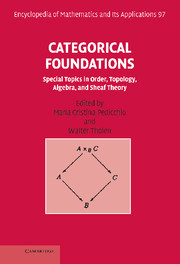Book contents
- Frontmatter
- Summary of Contents
- Preface
- Contents
- Introduction
- I Ordered Sets via Adjunction
- II Locales
- III A Functional Approach to General Topology
- IV Regular, Protomodular, and Abelian Categories
- V Aspects of Monads
- VI Algebraic Categories
- VII Sheaf Theory
- VIII Beyond Barr Exactness: Effective Descent Morphisms
- Index
II - Locales
Published online by Cambridge University Press: 05 November 2013
- Frontmatter
- Summary of Contents
- Preface
- Contents
- Introduction
- I Ordered Sets via Adjunction
- II Locales
- III A Functional Approach to General Topology
- IV Regular, Protomodular, and Abelian Categories
- V Aspects of Monads
- VI Algebraic Categories
- VII Sheaf Theory
- VIII Beyond Barr Exactness: Effective Descent Morphisms
- Index
Summary
This chapter is an introduction to the basic concepts, constructions, and results concerning locales. Locales (frames) are the object of study of the so called point-free topology. They sufficiently resemble the lattices of open sets of topological spaces to allow the treatment of many topological questions. One motivation for the theory of locales is building topology on the intuition of “places of non-trivial extent” rather than on points. Not the only one; hence it is not surprising that the theory has developed beyond the purely geometric scope. Still, we can think of a locale as of a kind of space, more general than the classical one, allowing us to see topological phenomena in a new perspective. Other aspects are, for instance, connections with domain theory [53, 52], continuous lattices [5, 31], logic [65, 20] and topos theory [42, 20].
Modern topology originates, in principle, from Hausdorff's “Mengenlehre” [30] in 1914. One year earlier there was a paper by Caratheodory [23] containing the idea of a point as an entity localized by a special system of diminishing sets; this is also of relevance for the modern point-free thinking. In the twenties and thirties the importance of (the lattice of) open sets (which are, typically, “places of non-trivial extent”) became gradually more and more apparent (see e.g. Alexandroff [1] or Sierpinski [54]). In [57] and [58], Stone presented his famous duality-theorem from which it followed that compact zero-dimensional spaces and continuous maps are well represented by the Boolean algebras of closed open sets and lattice homomorphisms.
- Type
- Chapter
- Information
- Categorical FoundationsSpecial Topics in Order, Topology, Algebra, and Sheaf Theory, pp. 49 - 101Publisher: Cambridge University PressPrint publication year: 2003
- 4
- Cited by



